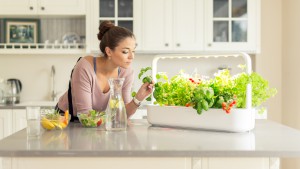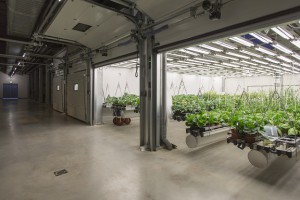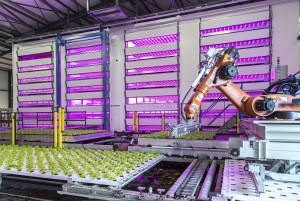The conference “Revolution in Food and Biomass Production (REFAB)”, Cologne, 1-2 October, allows a deep look into the future.

Food in our supermarkets has often travelled hundreds of kilometres. What if, nowadays, we have better options for producing healthy, tasty food with lower carbon footprint? Through indoor farming in our kitchens, vertical farming under controlled conditions at industrial scale and outdoor urban gardening methods, healthy food can be produced efficiently and locally.
Urban farming is the practice of cultivating, processing and distributing food in built-up areas and allows to produce food on rooftops, parks, houses, walls, warehouses and other unexpected settings. It is also being integrated into modern architecture and design concepts, with architects and designers combining their expertise to create beautiful environments with integrated food production. Urban agriculture has the advantage that food could go from farm to table in hours rather than days or weeks, cutting transport over long distances to save costs and fuel.
The inFARMING® project from Fraunhofer UMSICHT (Germany) concentrates on utilizing existing rooftops, trying to connect established greenhouse technologies with new concepts and innovative process and material research to meet the specific requirements of the available infrastructure. It integrates production of food in the city by using energy and water flows of the facility, which leads to lower energy usage and savings in carbon dioxide emissions as well as the resource consumption for food production. Internationally, more and more cities integrate such concepts in their city planning.

Home farming is an example of urban gardening, which brings food production into your home. Different technologies are already available that fit into kitchen counters or on balconies. For tech fans, mini farms with hydroponics systems up to the size of a fridge are already available on the market. These technologies can be operated via smartphone and allow to control parameters like the light intensity or water and nutrients flow. Micro scale farming at home will develop into a constant food source that covers a part of our nutrient need and even work without using soil.
The Estonian company Click & Grow will present their developed home gardening solutions, which measure the vital requirements of plants automatically. A nano-tech growth medium then releases exactly the right amount of water, oxygen, and nutrients for optimal plant growth.
Another urban agricultural practice is vertical farming where food crops are grown in stacked layers or shelves. These farms are decoupled from the environment and everything from temperature over lighting to watering is engineered to replicate traditional outdoor farming under ideal and controlled conditions. The term “while some try to modify a seed to match the environment, the environment is modified to match a seed” describes vertical farming quite well. Vertical farming promises a more than 300 times higher productivity compared to a commercial farm. This is possible due to a highly automated farm with a season independent operation time of 365 days a year, leading to more crop cycles per year with increased growth rate and higher yield. Further advantages of vertical farming are independence from environmental influences like seasonal changes, droughts, bitter cold, fires, and floods. Due to the closed loop system, pesticides can be avoided and 90 percent less water than at traditional farms is required. Every plant has its own light requirements, which can be met by controlling the light spectrum, intensity and frequency. This allows to increase yields, reduce growing times, and even influence the taste, appearance and nutritional content of plants.

The Dutch company Certhon designs and builds modern turnkey greenhouses and multilayer cultivation systems for the horticulture sector. In terms of daylight free cultivation systems, Certhon integrates all the necessary components for optimal climate management like heating, cooling, lighting, irrigation, CO2 and growing tables for every crop. In the last years, Certhon has learned lessons in the development of indoor and vertical farming and will share their experiences at the conference.
The German company OSRAM, as one of the global leaders in lighting technology, is at the forefront of advancements in horticultural lighting providing everything from single LED grow lights to complete solutions. OSRAM can create virtually any light environment with its intelligent light systems to influence factors like the vitamin content of tomatoes and intensity of basil.
Global interest is huge. Countries like India and China are expected to witness the fastest market growth in Asia, but in Berlin alone there are more than 50 indoor vertical farms up and running. Big investors like Wal-Mart, Amazon or GV (formerly Google Ventures) are heavily investing in vertical farming startups and indoor farming technologies.
However, challenges remain: The growth of vertical farming sector is largely affected by operational costs for LED lightning, climate control, labor and space. Further hindrances are high initial investment costs and current limitations on the variety of crops grown. Many of the mentioned forerunners of urban, home and vertical farming, such as Certhon, inFARMING®, OSRAM and Click & Grow, are working on these issues and will present their latest developments and visions at the conference “Revolution in Food and Biomass Production (REFAB)”, 1-2 October in Cologne, Germany. Altogether, 50 speakers and an exhibition will show the future of food and biomass production (www.refab.info). The call for papers is open until mid of May, the preliminary programme can be found online.
Source
nova-Institut GmbH, press release, 2018-04-18.
Supplier
Certhon
Click & Grow LLC
inFARMING
OSRAM GmbH
Share
Renewable Carbon News – Daily Newsletter
Subscribe to our daily email newsletter – the world's leading newsletter on renewable materials and chemicals










